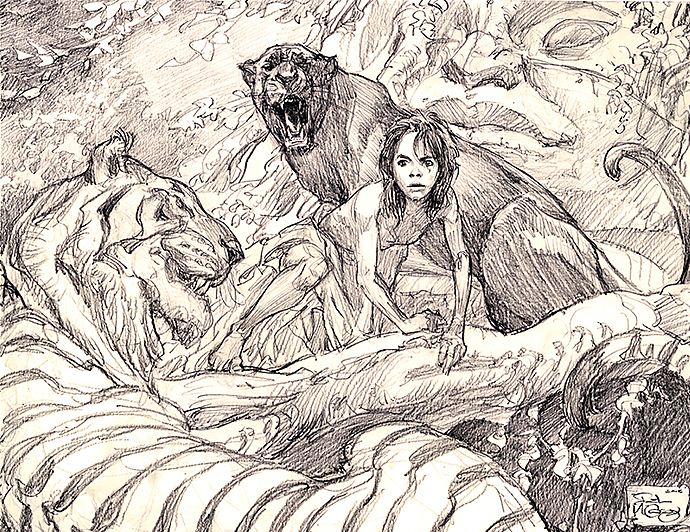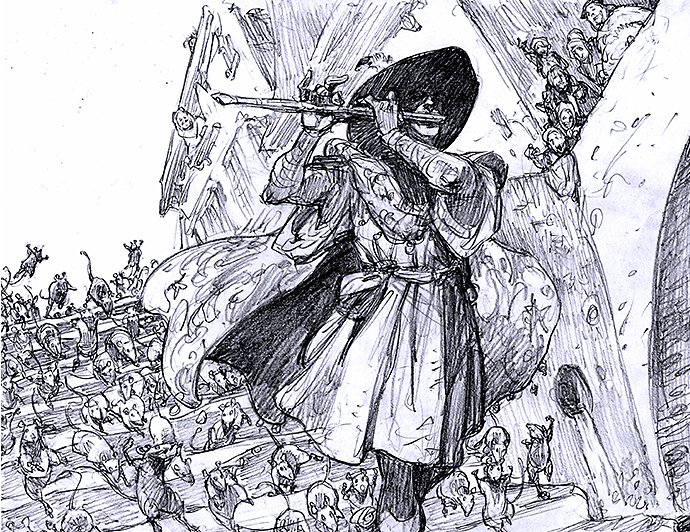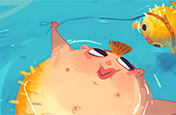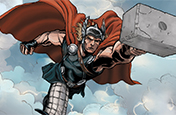Bring an idea to life with concept art.
How are ideas brought to life as visuals? From films to video games, concept art is a vital part of visual storytelling. In this article, we’ll explain the definition of concept art, what it can be used for and why it’s so useful - whether you’re a budding creative or a working pro.

When ideas become reality.
Concept art is an essential first step in the entertainment industry for visual and story development. “Everything that you see in a film, especially in a fantasy or sci-fi film, is usually first done by a concept artist,” says Karla Ortiz, an illustrator and concept artist. Concept art takes the form of illustrations, drawings, paintings, sculptures and models in both traditional and digital media. It is highly collaborative, with many iterations between artists and the director before any concept moves on to production.
“Concept art is like a crystal ball for the makers of films or games, giving them a snapshot of what their project might look like before they’ve made it. It’s a combination of visual storytelling, design and detective work,” explains veteran concept artist Iain McCaig. Before, during, or after the creation of a script or design document, directors and game developers put their imaginations on the table with the help of concept artists.
Different kinds of concept art.
While smaller productions usually need only one or two concept artists, large productions employ teams of concept artists, with specialists in different areas.
Sci-fi films or fantasy video games often take place in locations not of this world. That’s where concept art comes in. Whether it’s the desolate ice planet Hoth in Star Wars or the sparkling utopia of Wakanda in Black Panther, environment concept art sets the look of the world, real or imagined. World-building is a unique art, a combination of natural history, geology, sociology and many other ‘ologies,’ with the prime directive of serving the story.


Artwork by Karla Ortiz. © 2020 Karla Ortiz. All Rights Reserved.
Character and costume design
Stories must have heroes, villains and all their supporting players. Since not all of them are naked, they must have costumes too. Character designers seamlessly weave together what each character looks like and what they wear with who they are and what role they play in the story. From gods and monsters to regular human beings, concept artists wrestle them into being throughout the character design process with art skills, observation, research and their own innate inner actors.
Precision and detail are essential. “When it comes to costume design, you really want to be clear about the designs you’re sending. If you are designing armour, it should clearly read as armour, not leather or tech,” says Ortiz.
Every object tells a story, from a battered old book to a brand-new time machine. Prop and tech designers tackle all this conceptual art, from the iconic One Ring in The Lord of the Rings trilogy to the kit-bashed tech of Angry Max: Fury Road. Well-designed props and tech are vital to a cohesive look and feel of a game or film.

Artwork by Iain McCaig. © 2020 Iain McCaig. All Rights Reserved.
Creature design
“There are literally no limits to what a concept artist might be called on to create in service of the story,” notes McCaig. From the towering Kaiju in Pacific Rim to the terrifying Indominus rex in Jurassic Park, creature and monster designs are a speciality all their own. Since these creatures don’t exist in the real world, it’s entirely up to the visual development artists and designers to give them life and make them look believable. When drawing monsters, consider the environment in which they live and use real animals as references. If it’s a water-dwelling creature, will it need to breathe air like a mammal or use gills like a fish? Grounding your designs in the real world will make the end result more believable and realistic — even if the design is anything but real.
The concept art process.
At the heart of every film or game is a story. Concept artists work from a script, an outline or a verbal pitch. Their goal is to show the creators what their story might look and feel like before those creators commit to spending millions of production dollars. “This way, money isn’t wasted on things that we don’t need. It also helps set the look and the tone: a blueprint for production,” explains Ortiz.
There’s usually a briefing process between the concept artist and the director or art director at the beginning of a project. This is the time for the artist to gather as much information as possible to inform their concept designs. It’s a cross between detective work and a game of Twenty Questions, with some archaeology thrown in for good measure.


Artwork by Iain McCaig. © 2020 Iain McCaig. All Rights Reserved.
Concept artists then create many iterations of design and story solutions. “These are presented to the story creators, who choose the images that best fit their vision. Often, they ask for adjustments to the art. It’s not dissimilar to what actors do in crafting their performances, giving the director variations within their skills and craft,” explains McCaig.
From there, artists make changes and tweaks to their designs and send the final product along to the next department. Depending on the design, they could be sent to the costume designer, the production designer, animators or the art department. Keep in mind that concept art is a team project, focused on bringing the vision and story to life.
Tips for mastering your craft.
Get comfortable with your tools.
When you’re confident in your skills and your materials, you’ll create better work. Whether you start with pencil on paper or work in Adobe Photoshop (or do digital painting and sketching in Adobe Fresco on a tablet), use the tools that work for you. But keep in mind that you’ll probably need to make a digital version of your designs. “All of my final work is delivered in a digital format — even my pencil drawings are scanned,” notes McCaig.
“You have to know about your subject. Let’s say you’re trying to paint a portrait. Do you know the anatomy? Do you know how skin reacts in light? If you don’t know, find out. And if you have that knowledge, but it’s still not looking right, then you just need to practise,” says Ortiz. Drawing, painting and illustrating is a muscle. To get better you need to exercise your skills, so keep making more art.
Find your unique point of view.
“You won’t go anywhere in the entertainment industry if you don't know your craft, but the one unique thing you have to offer the world is who you are. Putting your own unique vision into what you do is what makes good art great,” explains McCaig. “Finding your voice or style is as simple as keeping an inspiration sketchbook. Put one drawing in there every day of something that creates strong emotions in you. Collect these images for a few months and then look back through the sketchbook. What you see will be a snapshot of your soul.”
When you paint and create for a living, you can get burnt out and uninspired. Keep your passion for art and illustration alive with projects just for yourself. “I always remind people of the importance of personal work. I always make time for myself to pursue new paintings, whether it’s an interesting freelance project or even if it’s just painting for myself,” notes Ortiz.
Concept art can seem intimidating, but if you work hard at your craft and infuse it with your personal vision, the ability to put your imagination onto screens big and small will be at your fingertips.
Contributors
Quick designs. Big impact.
Make customised designs fast with Adobe Express. It’s easy to create something amazing in just a few clicks.
You might also be interested in…
How to become a professional illustrator.
Get tips on portfolio creation and art presentation to help you kick off a new career.
Explore the art of sequential storytelling and learn how to hone your skills to work in this exciting medium.
Working with digital pens and other digital drawing tools.
See how you can bring the freedom and convenience of digital drawing technology into your workflow.
Take your skills to the next level with drawing exercises and advice from professional illustrators.



